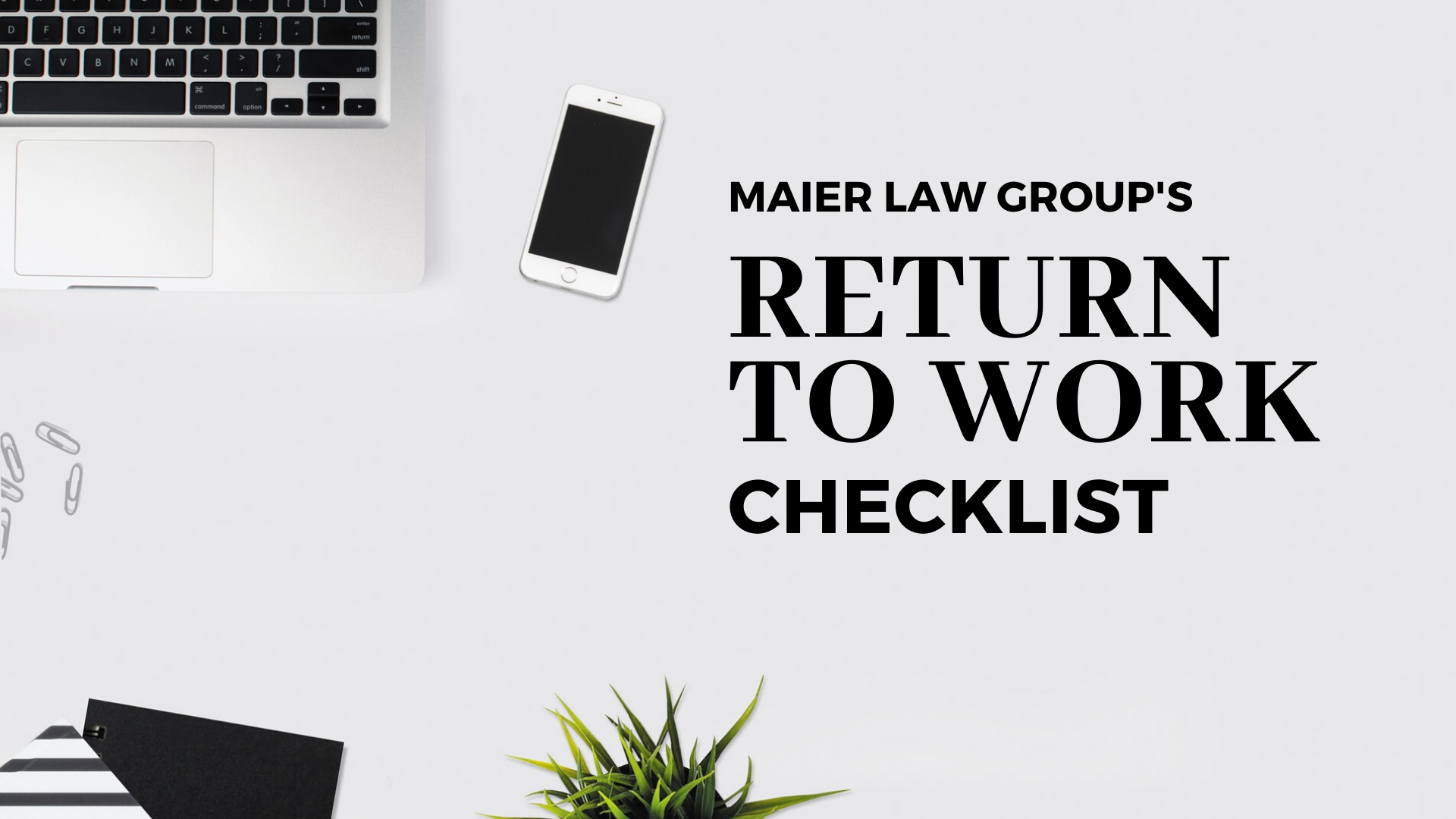Ready to Re-Open the Workplace?
A Checklist for Employers
In the past several weeks, more and more businesses are attempting to resume “normal” operations. But the new normal is strikingly different from what came before and there is no one magic formula that works for every business.
It’s no surprise, then, that businesses find themselves in a constant state of uncertainty as they adjust their operations and staffing for reopening. In doing so, employers must meet both the needs of their clientele while also maintaining the safety of employees, clients, and customers.
Maier Law Group (MLG) has created this checklist to aid your efforts as employers. Although not exhaustive, this checklist contains the most important protocols, documents, and policies to consider implementing (or updating) to ensure legal compliance and safety in your workplace.
Reopening the Workplace
Site-Specific Social Distancing Protocol. To ensure customer and employee safety, forms explaining social distance protocol generally need to be posted at the entrance to, and common areas of, all businesses. These forms are county specific and industry or profession specific so businesses may need to check in either with their licensing board, county safety department, or both. Businesses with multiple locations, facilities or offices should ensure that the appropriate county form is used at each location. Most of these forms can be found with a simple internet search.
Health & Safety Plan. California businesses have always been required to have an Injury and Illness Prevention Plan (“IIPP”) for keeping employees safe. Now a separate plan needs to be created – or included in the IIPP – that ensures employee safety and outlines related protocol. This plan should be comprehensive and include physical distancing protocol in the workplace, protective equipment employees must wear, the screening necessary for employees and clients as they enter the workplace, the employee departments that can work remotely, etc. Given the breadth of information that should be included in this plan, we recommend referring to guidance from the Centers for Disease Control on this topic and having your draft plan reviewed by an employment attorney or a qualified HR specialist.
Adjusting to Long-Term Remote Work for Part or All of Your Staff
Work from Home (“WFH”) Policy. If any of your employees work from home, we highly recommend implementing a WFH policy. For non-exempt employees, this policy should most importantly detail how to comply with wage and hour requirements: rest breaks, meal breaks, and overtime. For all employees, the WFH policy should address data privacy and security requirements, reasonable business expense reimbursement, tracking non-exempt hours and paid break times, schedule and availability expectations, etc.
Bring Your Own Device (“BYOD”) Policy. A BYOD Policy is essential when employees start moving sensitive data (employees’ health, disabilities, and medical status; identification numbers, etc.) that resides in a secure server to a laptop or other local device (which occurs any time they download something from the secure server and save it to their device.) Downloading any kind of private information to an unsecured or lesser secured laptop, increases the risk of that information’s exposure or even interception in transit from the original to new storage site. Companies should also draft a Computing Security and Use Policy governing what is and isn’t acceptable use of computing resources. This policy should contain: provisions prohibiting harassment over social media, permitting email for business use only (or notifying employees certain personal use is fine), notifying employees that emails and other items generated with company resources is property of the company and can be searched for a legitimate reason, and many other such provisions). Computing protocol and security are vital to address during this time when virtually everything work-related is conducted over a computing platform.
Updated AND New Sick Leave Laws
Internal Policies. Since the onset of the pandemic, there have been a number of changes to federal, state, and local laws regarding employee paid sick leave entitlements. We highly recommend that businesses update their internal policies accordingly, either through updates to their handbook, or the creation of stand-alone leave policies to supplement their handbook. Handbooks should be updated annually anyway, so this is a good chance to make sure its content is legally compliant. Updated handbooks or stand-alone leave policies should be distributed to all staff.
Families First Coronavirus Response Act (FFCRA). If you haven’t already, circulate the Department of Labor’s Families First Coronavirus Response Act’s poster to staff working remotely. You must also post it in your physical workspace. Be sure to provide the poster in the language(s) spoken by staff. Posters in different languages can be found on the Department of Labor’s website.
Of course, these are just a few of the things we recommend, but are among the most important. If you feel you need additional guidance or help with these documents, please contact us.
Authors: Diana Maier, Partner and Caitie Emmett, Associate.
The Maier Law Group is a boutique employment and data privacy firm that specializes in conducting workplace investigations, providing executive coaching, training employees, mediating both courtroom and workplace disputes (between two conflicting employees), and advising and counseling employers on HR and data privacy issues.
This article has been prepared for general informational purposes only and does not constitute advertising, solicitation, or legal advice. If you have questions about a particular matter, please contact the Maier Law Group directly at info@maierlawgroup.com.









